South America's Last Crusader
Painting by Juan Lepiani, which depicts the first associates of Pizarro - "Glorious Thirteen" ("Thirteen, sung with fame"). Legend says that in the year 1527, having received an order to return to Panama, Pizarro drew a line on the sand with the sword and invited the soldiers who suffered hardships and famine on the island of Gallo to follow him: “Here is Peru with its wealth; there is Panama with its poverty. Choose, each of you, what is best for the brave Castilian. ”
Now it’s time to talk about Francisco Pizarro, who repeated the acts of Cortes in South America. He defeated the state of the Incas, the culture of which was also described in detail here at VO, and he obtained a fantastic amount of gold and silver for his thugs and the beloved king. And ... did not lose it, as lost the loot gold of Cortez in the "Night of Sorrow". That is, in all respects proved to be a more successful conquistador. And the state of the Incas was great. It was located in the territories of modern Peru, Chile, Ecuador and Bolivia, that is, there was much more of the Aztec empire. Although it was beneficial for the Spaniards to present the Incas as illiterate savages, a study of their history and culture showed that the Incas had their own writing and chronicles. Well, the number of the Incas themselves and the peoples they conquered, such as Quechua and Aymara, could reach 10 millions of people, of whom approximately 200 000 men served in the Inca army. So the task before Pizarro was even more difficult than the one that stood in front of Cortez, and ... he coped with it very well!
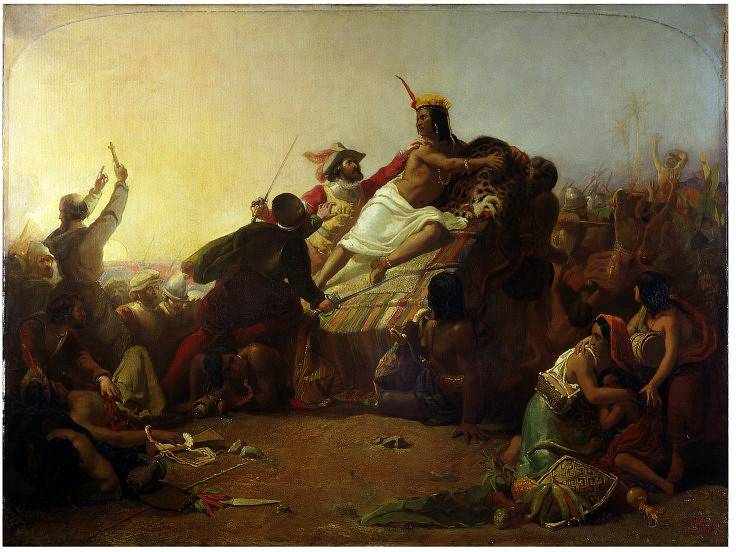
Painting by John Everett Millet. "Pizarro takes Atahualpa captive." 1845 (London, Victoria and Albert Museum)
The Spaniards learned about the existence of the Inca Empire in 1525, after the completion of the first Southern Expedition, which was led by Francisco Pizarro along with Diego de Almagro. Interestingly, the Pizarro expedition coincided with an important event for the Inca: in their country there was a civil war between the claimants to the throne, in which Prince Atahualpa eventually became the winner. The expedition left Panama 14 on November 1524 of the year, and soon reached the territory of the Inca state, but due to hostilities returned back to 1525. But the Spaniards left no hope that one way or another they would be able to find out everything about this country and organized two more expeditions there.

Portrait of Francisco Pizarro. Amable-Paul Kutan (1792 – 1837). (Versailles, Paris)
Returning to Panama, Pizarro reported on everything to the governor, but he was either a fool or a reinsurer and refused to give him people to conquer Peru. But he could not forbid Pizarro to go to Spain. And there he received an audience with Charles V and told him in detail about his plans. The monarch was smarter, gave the conquistador the rank of captain-general, but most importantly, money and troops. Although a bit. Only three small vessels, 67 riders and 157 infantrymen, armed with cold weapons - pikes, spears and swords. In addition, he was given 20 crossbowmen with powerful crossbows, but only 3 (!) Soldier-cooler and two small guns!
Surroundings Cusco. Ollantaytambo fortress.
On the coast of Peru, with all his people, Pizaro arrived in 1532. By this time he had 200 foot soldiers left and only 27 riders who had horses. But here, in the same way as in the case of Cortez, his “army” immediately began to be replenished with Indians of the tribes, whom the Inca domination had not been satisfied for a long time and who had only waited for an opportunity to rebel against him. The Incas themselves were ready to fight the conquerors who came to them, but their empire was weakened by internecine war. Each of its participants hoped to use the Spaniards to their advantage, hoping that later he would cope with them without difficulty. But the most important thing is that the Spaniards brought smallpox and measles in Peru - the most reliable weapon of Europeans in their struggle with the Indians. And it was from her that the Inca warriors died the most!
Ollantaytambo fortress. On these terraces one could not only defend, but also grow crops!
The conquistadors had already occupied several Incan cities, when the Inca army came forward to meet them. Atahualpa knew that the messengers told him that the aliens had unprecedented weapons, but he was a limited man and was not imbued with the consciousness of imminent danger from the Spaniards. The commander-in-chief, Ruminiavi, was sent to attack the newcomers from the rear, while at the head of an eighty thousand-thousandth procession he headed to the city of Cajamarca, which had been captured by the Spaniards. Why he took with him only about 7000 people, and the rest of the army left the city, is unknown. No sources report this. Maybe he was so confident in his power that he considered the strength of the Spaniards too insignificant? Or did the gods advise him? Who knows…
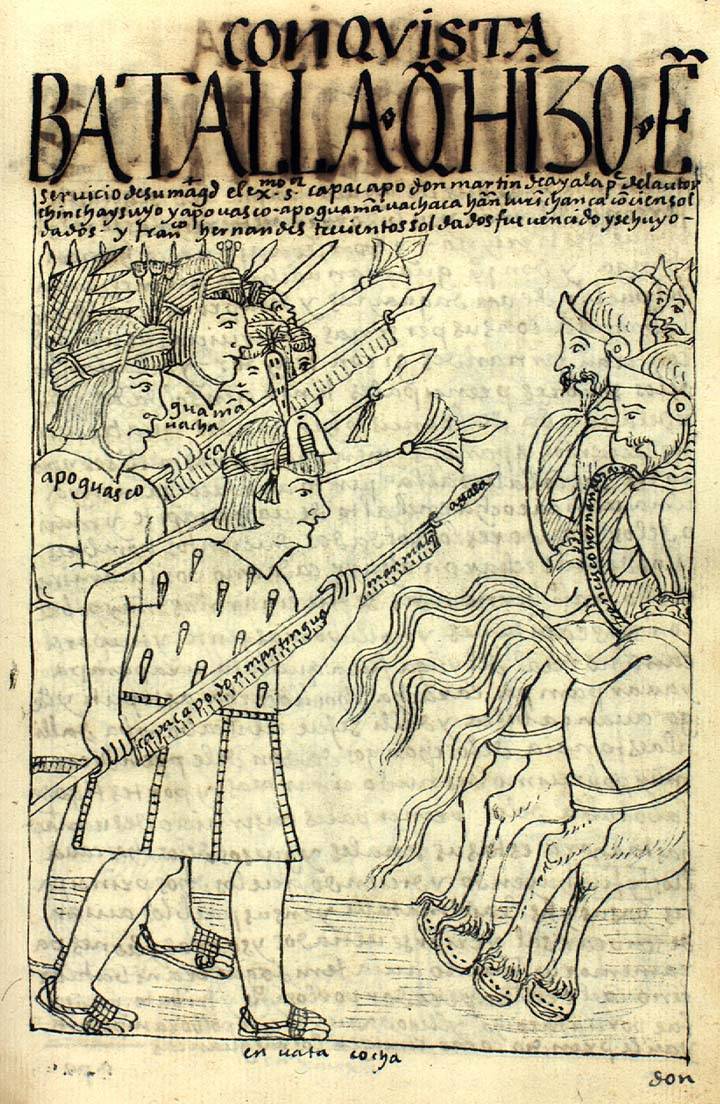
The battle between the Incas and the Spaniards. Chronicle of Felipe Guamana Poma de Ayyaly.
In any case, Pizarro, having under the command of the entire 182 man, was not afraid of the terrible greatness of the One Inca and took Atahualpa hostage on 16 November 1532 of the year. Moreover, the classic "incident of Belly" was used - Atahualpe was given a Bible and offered to be baptized. But he did not know what it was and threw it on the ground. For the blasphemy had to pay! The Indians immediately made a volley from the guns and the 12 arquebus, after which the horsemen attacked them. Of course, the Incas tried to save their ruler, but in such an unequal fight they could not but be defeated.
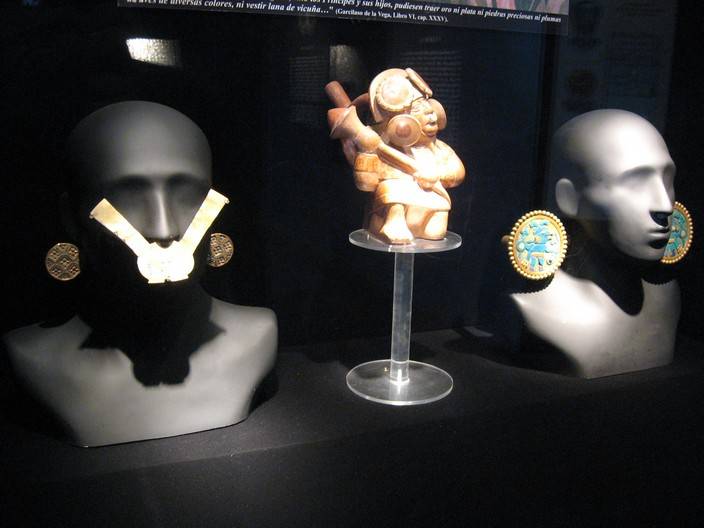
Decorations of noble Inca warriors. (Museum Larco in Lima).
In fact, the “battle” was a real massacre, in which almost all seven thousand devoted warriors of Atahualpa were killed, and he himself was captured. And the Spaniards have not lost a single person! Well, the Incas were completely demoralized. They didn’t know the guns, didn’t know the crossbows, never saw horses, armor and steel weapons, too ... The fighting style was unusual for them, and the wounds inflicted with steel weapons simply terrified.
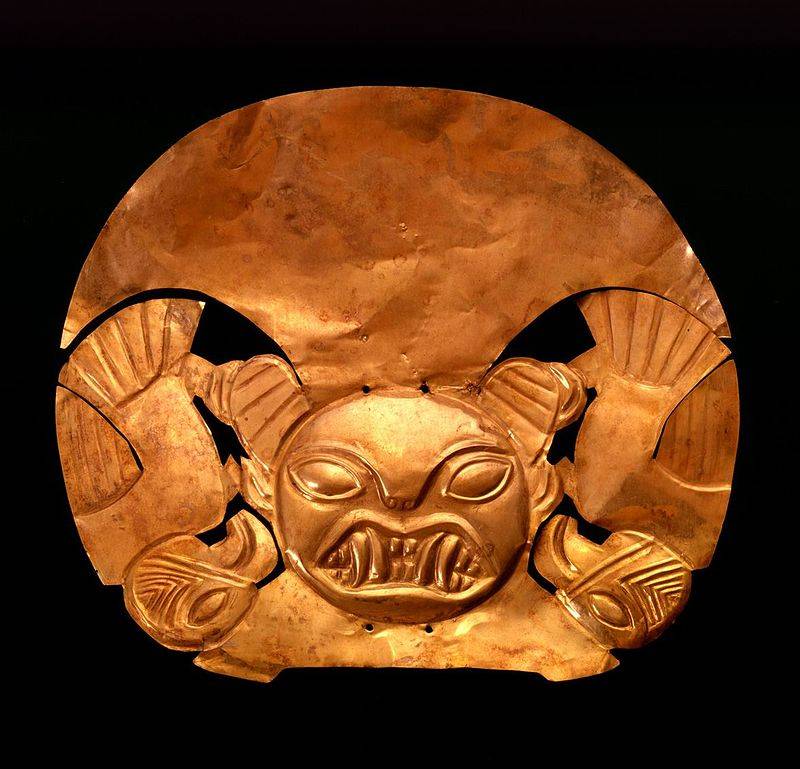
Golden Mask of the Indians Mochika culture (Larco Museum in Lima).
Well, then Pizarro demanded a ransom for the Great Inca. And in response, Atahualpa offered to fill the room in which he was kept with gold up to the ceiling with gold. When he heard this, Pizarro hesitated a little (which is not surprising, didn’t he ?!), but Atahualpa noticed this, did not understand the reason, or rather interpreted it incorrectly, and immediately promised the conquistador that he would fill the next room with silver. Then Pizarro came to his senses, realized that he had attacked a gold mine, and when he did, he noticed that the second room was much smaller than the first. And Atahualpa agreed with him and promised to fill it with silver twice!
Heads of the Inca copper. (Metropolitan Museum, New York)
For more than three months, the Incas had to collect gold and silver and deliver them to Cajamarca. At the same time, Atahualpa violated a very old and strict law, demanding: "so that no gold and silver entered the city of Cusco could be taken out of it on pain of death." But it was from Cuzco that the largest part of gold and silver was taken out! More than 34 days were spent only on melting gold and silver products into ingots. All this became the famous “Redemption of Atahualpa”, which later legends circulated, and which eventually made up a whole room with an area of 35 m², up to a mark at the level of a raised hand filled with gold and silver. Pizarro received a ransom, but still decided to execute Atahualpa. Moreover, the court decided to burn him, but if he adopted Christianity, he was promised to replace this type of execution with strangulation. And Atahualpa again agreed, because the Incas believed that only the preservation of the body guarantees a deceased life after death. And 26 July 1533, Atahalpu was strangled with garrote.
Painting by Louis Montero. “Funeral of Atahualpa 29 August 1533 of the Year”. 1867 (Lima Art Museum)
A notary Pedro Sancho reported “where it is necessary” that Francisco Pizarro received on the 18 buyout section on June 1533 of the year: gold - 57 220 pesos, and silver - 2350 marks. Francisco de Chavez, one of Pizarro’s associates, described these events in a slightly different way. In a letter from 5 in August 1533, he claimed that Atahalpu had been captured, having drunk him and his retinue with arsenic monosulfide (realgar), which made it easy to capture them captive, no one had any significant resistance to the Spaniards. Like it or not, now you will not know. Only one thing is known. Atahualpa was captured, he was offered to pay a ransom, he agreed, the ransom was received, after which he was executed as a heretic. Such was the fate of this near, though notable, "savage."
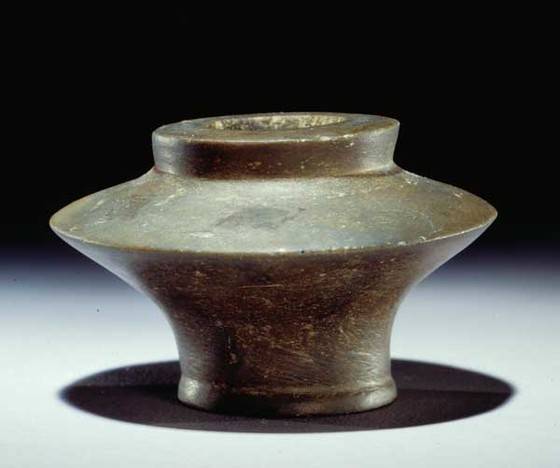
Peru, top maces. Chavin culture. OK. 800-200 BC. (Los Angeles County Museum of Art)
15 March 1573, the soldier of Uaskar Sebastien Yakovilka, also wrote that he personally "saw that after the death of Atabalipy don Marquis Francisco Pizarro also killed and ordered to kill a large number of Indians, commanders and relatives of Inka himself and more 20 thousands of the Indians who were thus with Atabalipa for waging war with his brother Vaskar. " And if this is true, then it turns out that the Incas at once lost a significant part of their army, and with it the will to further resistance!
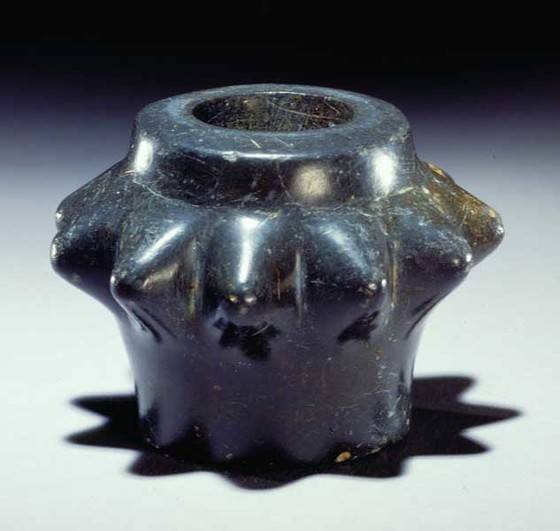
Peru, top maces. Chavin culture. OK. 800-200 BC. (Los Angeles County Museum of Art)
After the death of Atahualpa, the Spaniards made the Supreme Ynca Tupac Walpa, but he did not rule long. He was killed by his own commander. 15 November 1533, immediately after they succeeded in defeating another Inca army, conquistadors led by Francisco Pizarro seized the Inca capital city of Cuzco without much resistance and brought another puppet ruler Manco Inca Yupanki (Manco Capac II) to power . It is clear that the real power was completely in the hands of the Spaniards, who were not only humiliated by the new emperor, but also imprisoned in a prison, after he tried to escape from them in November 1535 of the year. True, it cannot be said that all the Incas surrendered and did not offer any resistance to the Spaniards. But the thing is that even when they tried to resist, there were always Indians from conquered tribes who came to the aid of the Spaniards.
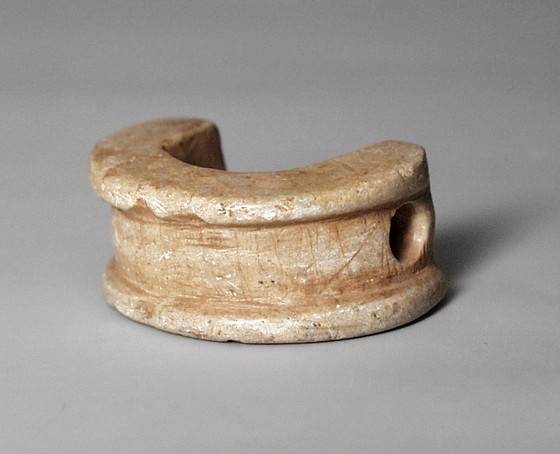
Atlatl's handle. A rock. Mexico, Guerrero, 500 BC - 100 AD (Los Angeles County Museum of Art)
Well, and then the Extremaduran, like Pizarro, Sebastien de Belalcazar went to Ecuador, where he defeated the Inca warlord Ruminyavi in a battle at Chimborazo. And then he met with five hundred people of the governor of Guatemala, Pedro de Alvarado, and the case almost got into a fight, because he himself hoped to plunder the Indians, and the place was already taken. However, the governor thought and decided not to drag along the jungle, not to have a temper, but to sell his ships and ammunition to another colleague Pizarro Diego de Almagro. And sold for a substantial amount of 100 thousand pesos in gold. After that, 6 December 1534, Belalcazar managed to seize the important fortress of Quito, but his expectations to find there the treasures did not materialize. And if so, then he continued moving to the north, hoping to find there the "golden country" of Eldorado and the "golden city" of Manoa.
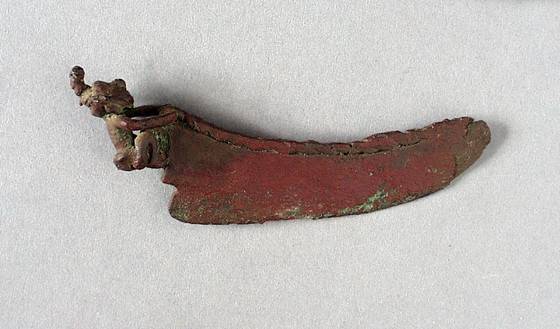
Inca ritual knife, 1300 - 1560 years. (Los Angeles County Museum of Art)
And Diego de Almagro went to the south and reached the land, which he called Chile, which means "cold." And the saddest thing is that the Indians as a whole were not at all treated as sadists and murderers, only for the Aborigines it turned out to be worse than their swords and bullets. From contacts with the Spaniards, many of them are sick. The epidemic has spread and the local population eventually declined ... five times! On the other hand, gold and silver just flowed into Spain, and previously completely unknown vegetables - corn and tomatoes, as well as cocoa beans - came to Europe. The Spaniards recognized the “secret” of why all the Indians had such beautiful teeth. It turns out that they knew a certain plant, the root of which was cut and heated on the fire to boil. Then this root with juice extracted from it was applied to the gums. It was, of course, very painful, but very effective. The operation was done in childhood and in adulthood, and the Incas, unlike the Spaniards, did not know any problems with their teeth ... But having described this method of dental treatment, they did not bother to find out what the plant was and this secret went away with the Incas!
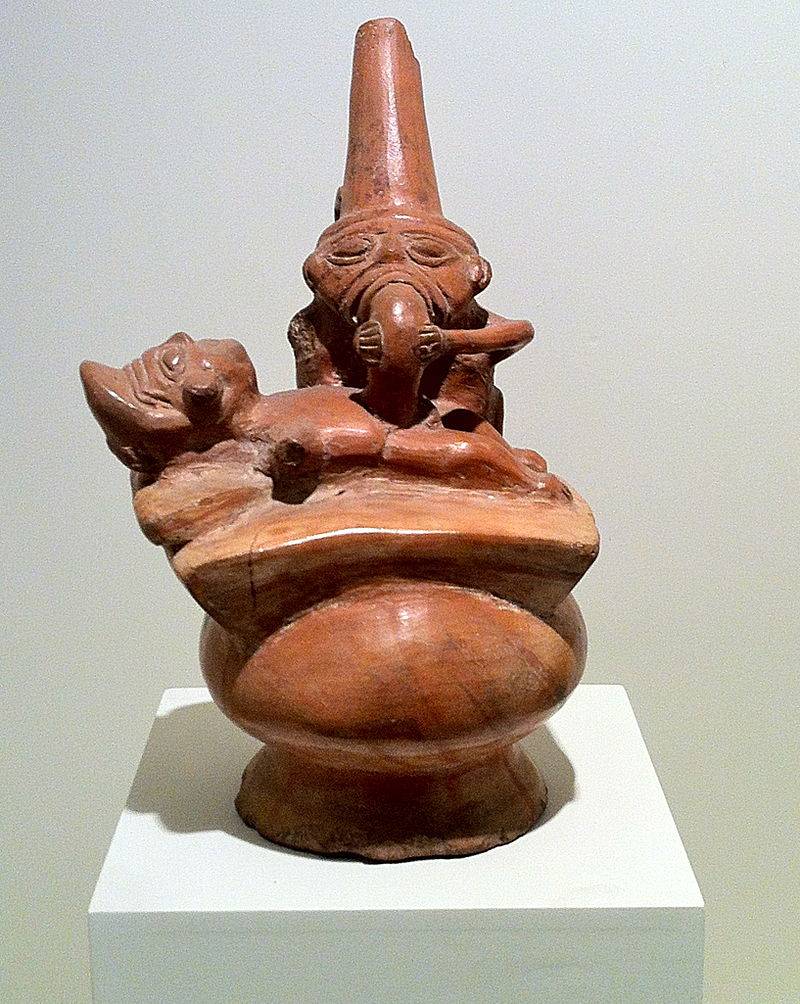
Not surprisingly, the Spaniards were cruel to the Indians, because in their eyes, the eyes of the orthodox Catholics, to the limit intimidated by the holy Inquisition, even the Inca crockery looked absolutely terrible. (Museum Larco in Lima)
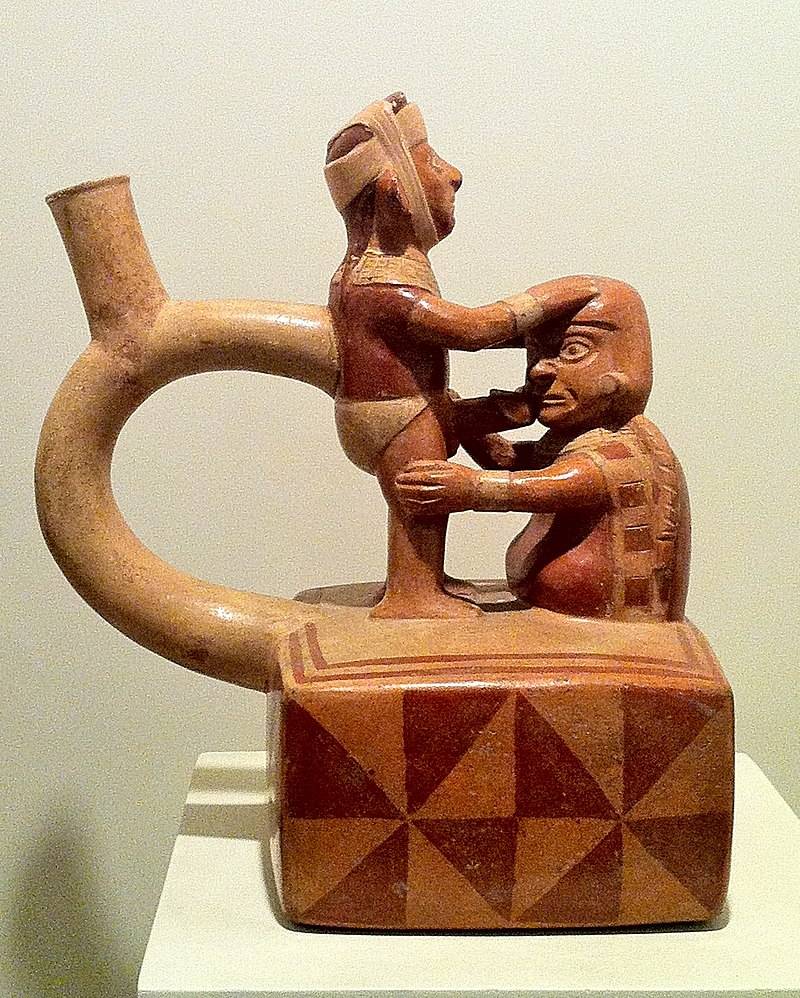
Or, let's say, this vessel. It is innocent in the eyes of anyone - an Indian, he plunged the Spaniard into horror. After all, there is only one way ... and everything else ... a terrible sin! (Museum Larco in Lima)
In January, 1535, Pizarro founded the city of Lima, which became the capital of Peru. And with 1543, it became the main center of Spanish domination in South America.
But for the Incas, they were perfectly normal artistic images. “And who does not do that?” They were surprised, looking at the Spaniards who were dead from the horror, looking at ordinary dishes. (Larco Museum in Lima)
It should be noted that Manco Inca did not give up his intention to escape from the Spaniards. Having shown patience and resourcefulness, he managed to deceive one of Pizarro's brothers - Hernando Pizarro, and ran away. And having escaped, the Inca rebellion took over its head. A chase was sent for him, but failed to return the fugitive. Meanwhile, Manko Inca managed to build an army, the number of which they say (or rather they write!), That it ranged from 100 000 to 200 000 soldiers; only 190 Spaniards opposed it, including the entire 80 riders, but several thousand Indian allies, however. The Spaniards besieged 6 in May 1536 in the city of Cusco, and as a result of a massive attack, almost the entire city was beaten off. The Spaniards took refuge in two large houses near the main square and decided to sell their lives dearly.
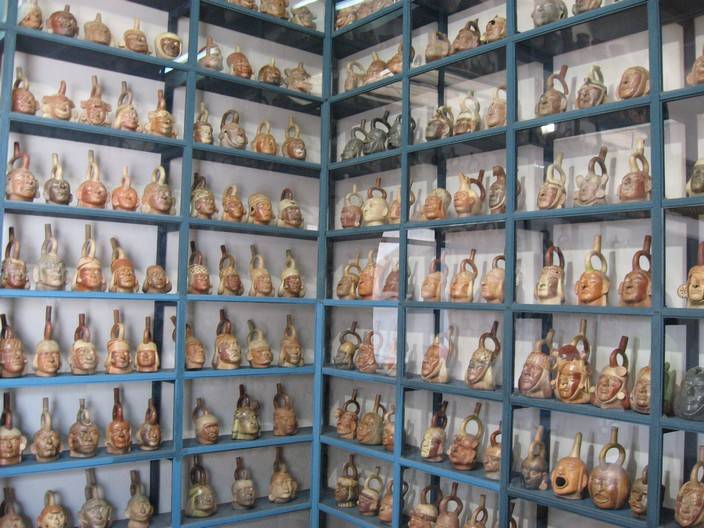
It’s good that at least they didn’t consider the portrait vessels to be the “devil's work” and they have been preserved for today. In any case, in the Larco Museum in Lima they literally clogged up all the premises of the storerooms.
They also managed to attack and repel the Saksayhuaman complex of buildings, which was their main base, and another Pizarro's brother, Juan, was mortally wounded in the head with sling stone. The capture of Saksayhuaman eased the position of the Spanish garrison in Cusco, but their position remained dire. Therefore, in order to strike them with horror, the Spaniards at this time killed all the prisoners, and in the first place - the women captured by them. As a result, it turned out that during the 10 months of the siege of Cusco Manco, Inca Yupanqui could not break the resistance of the Spaniards and decided to lift the siege. He hid in the mountain range of Vilkabamba, where the Inca dominion continued for about 30 years. And then the Spaniards, led by Diego de Almagro, returned from Chile and took Cusco on 18 on April 1537.
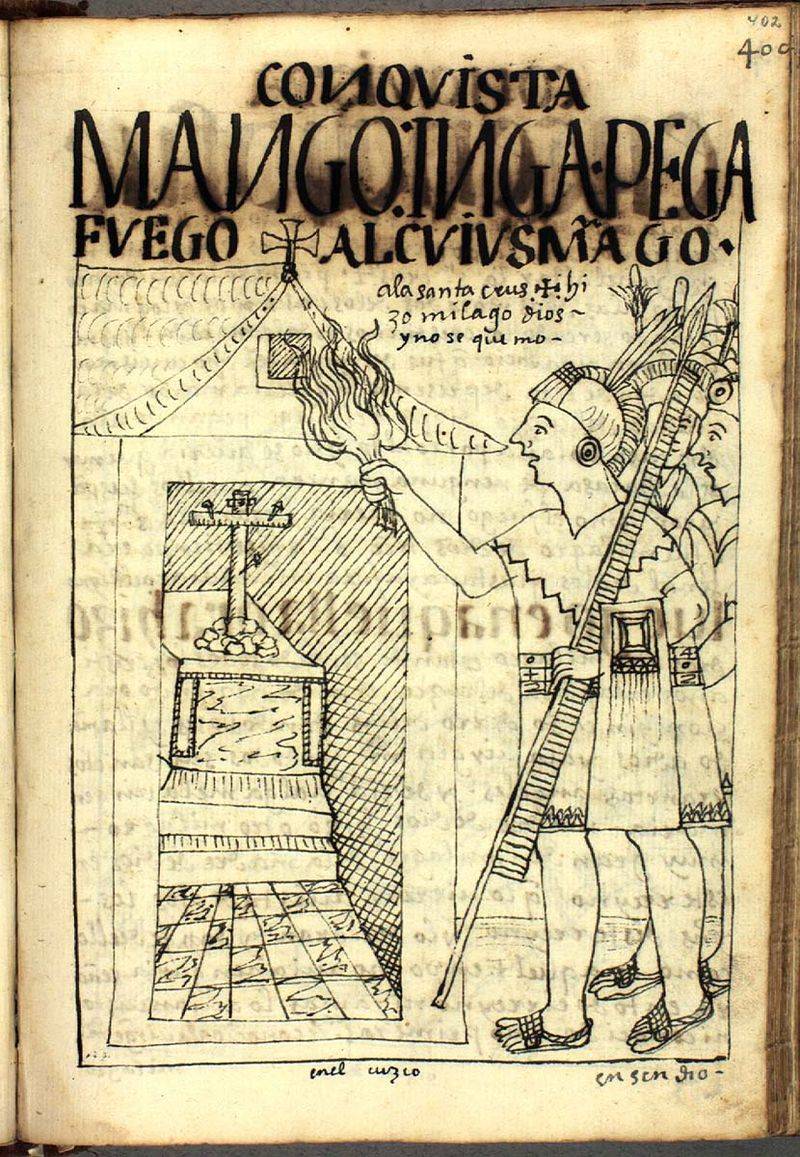
The culmination of the siege of Cusco Inca Manco and his warriors set fire to the roofs of the city. Chronicle of Felipe Guamana Poma de Ayyaly.
The fate of Francisco Pizarro was sad. He died in a conspiracy, which the Incas could only rejoice. But ... they still could not use it. Hiding in mountain fortresses, they fought with the conquistadors for more than forty years, until in 1572 the last Incan ruler, Tupac Amaru, was captured and beheaded by them. So ended the history of the empire Tauantinsuyu. Their state was destroyed, the culture of the Incas died.
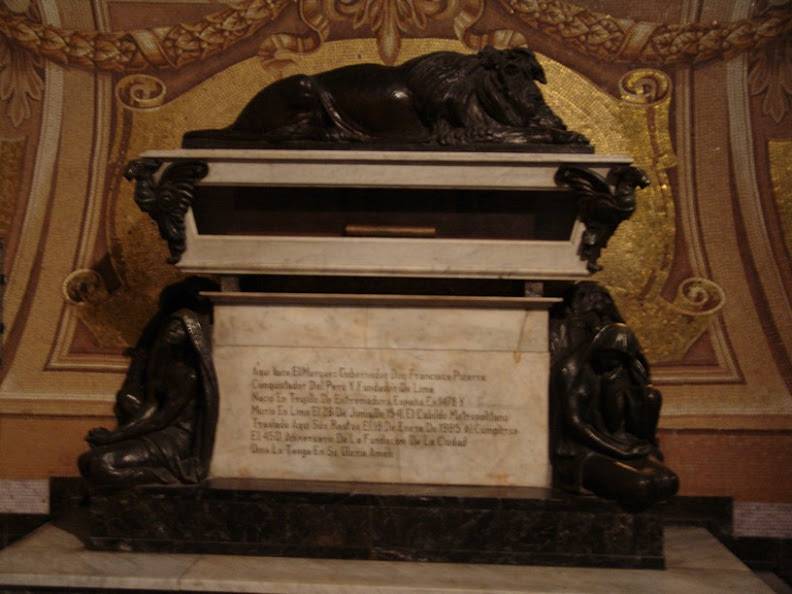
Tomb of Francisco Pizarro in Lima.
Well, the first major uprising of the Indians conquered by the Spaniards in Peru happened only in the 1780 year (that's how long they endured their domination!). And he was also headed by the Inca, who took the name Tupac Amaru II. The uprising lasted three years, but in the end the Spaniards suppressed it anyway, and Tupac Amaru and thousands of his associates, after brutal torture, were executed to intimidate all who remained.
Terraces of the mountain fortress Pumatallis
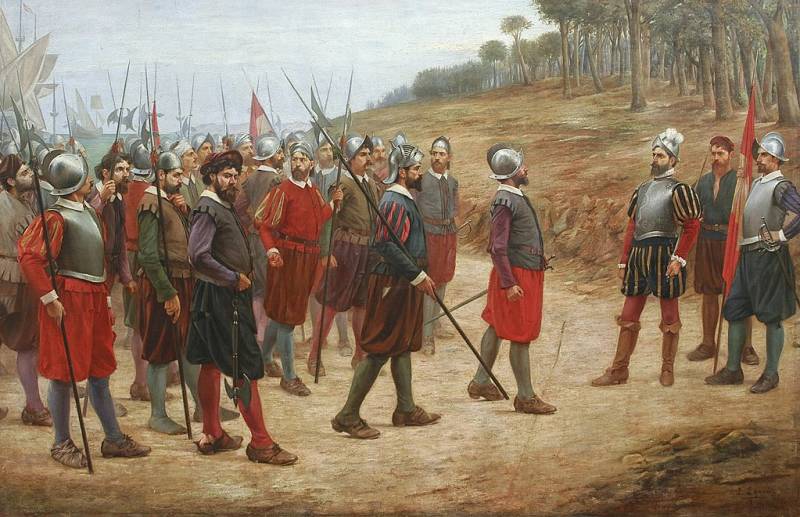
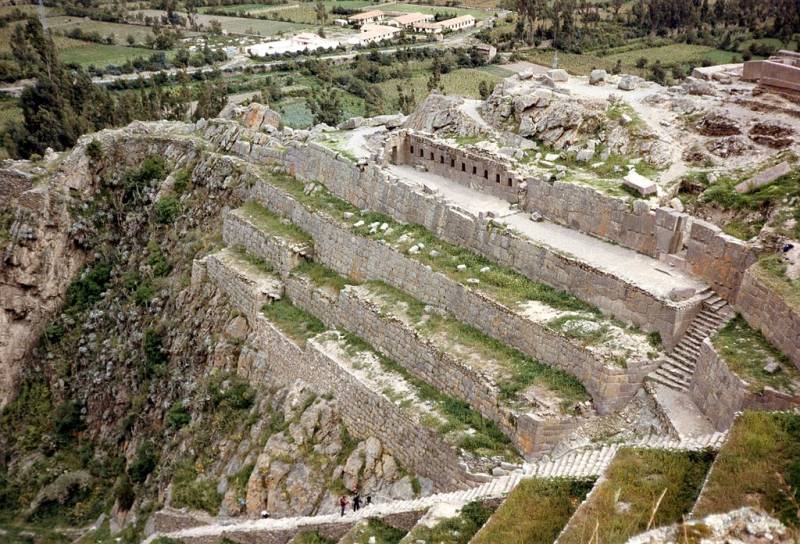
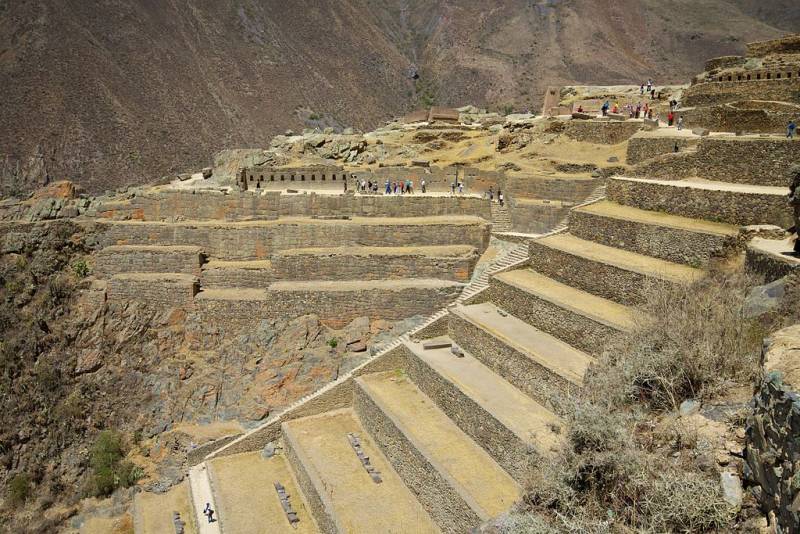
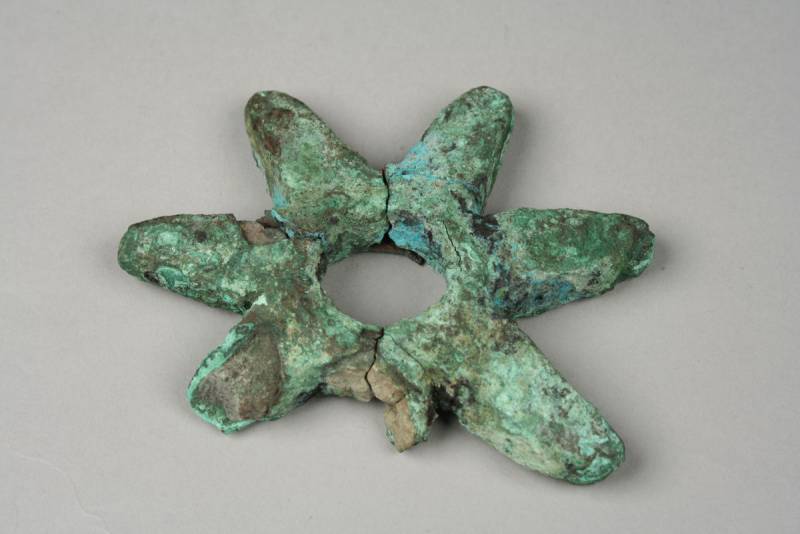
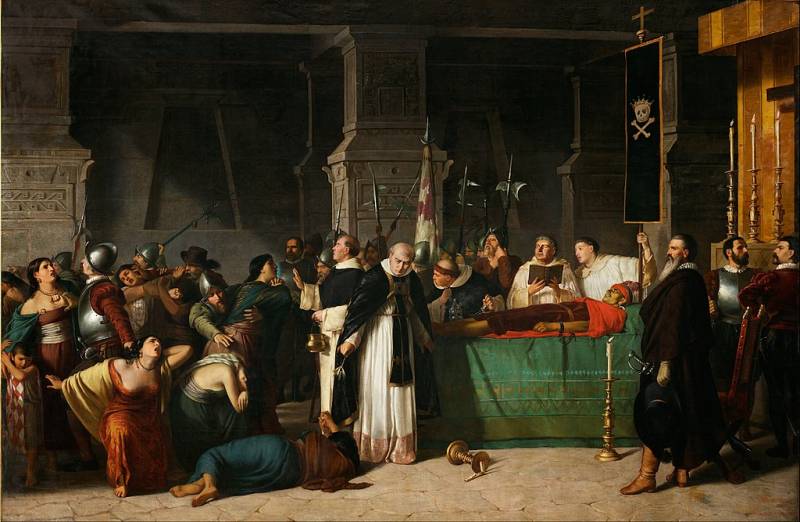
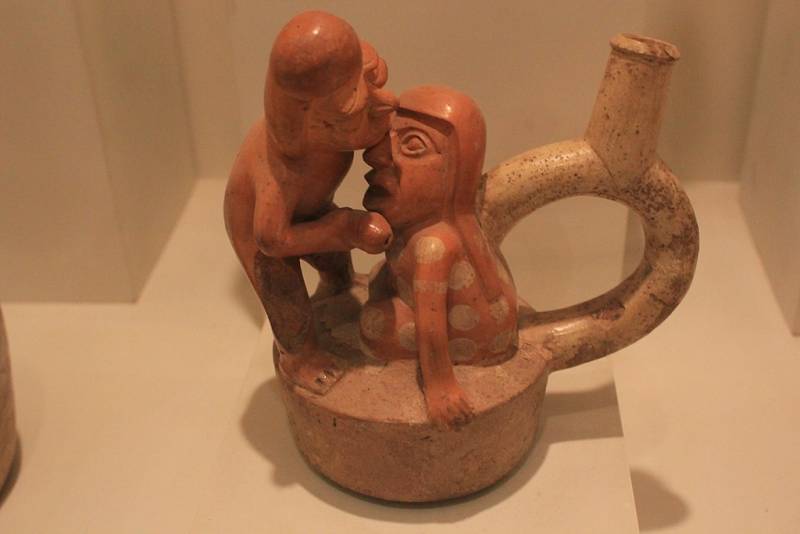
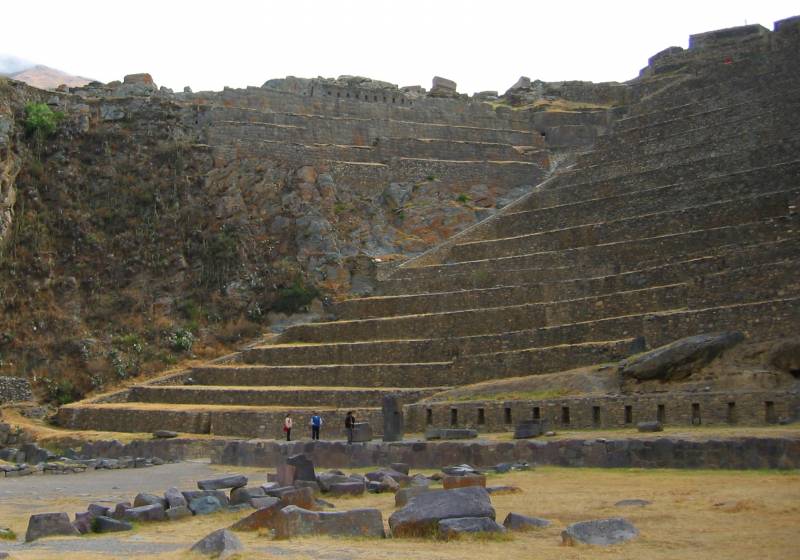
Information